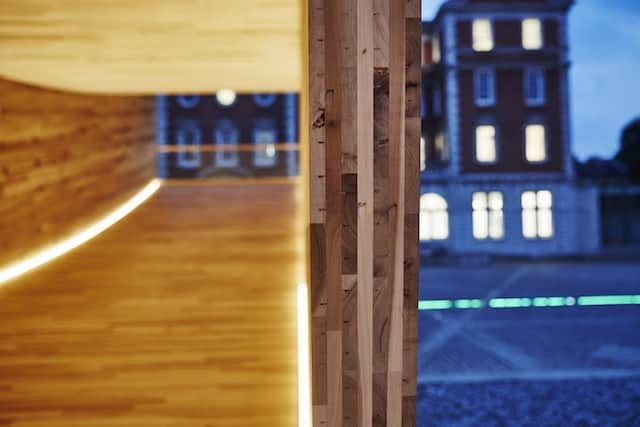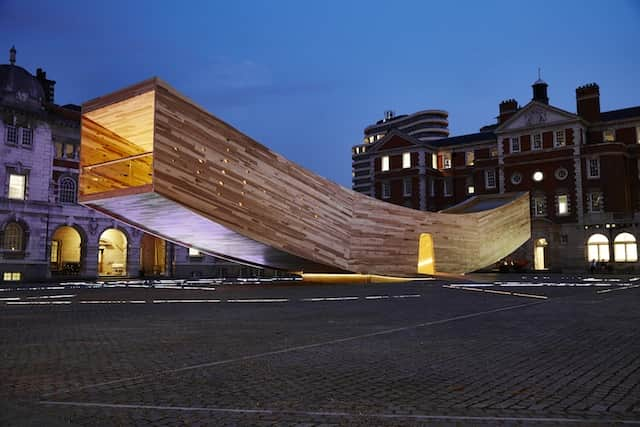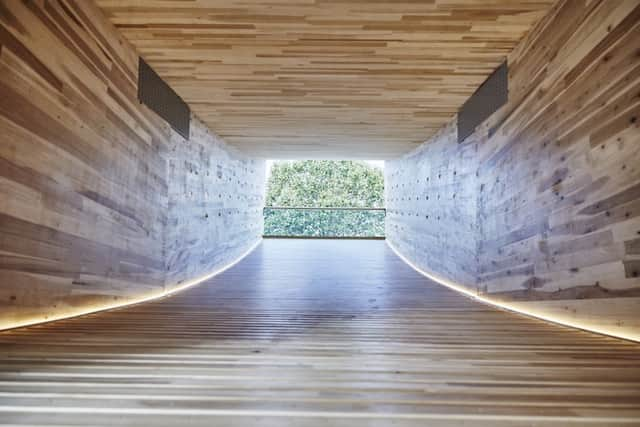
Landmark project remains on display at Chelsea College of Art Rootstein Hopkins Parade Ground until October 12 as part of London Design Festival 2016
‘The Smile’, a spectacular, curved, tubular timber structure measuring 3.5m high, 4.5m wide and 34m long, by the American Hardwood Export Council (AHEC), Alison Brooks Architects (ABA) and Arup has paved the way forward for the use of hardwood cross-laminated timber (CLT) in the construction industry. On display at the Chelsea College of Art Rootstein Hopkins Parade Ground until October 12 as part of London Design Festival 2016, the installation showcases the structural and spatial potential of CLT using American tulipwood. As one of the Festival’s Landmark Projects, which can be inhabited and explored by the public, ‘The Smile’ is effectively a beam curving up at both ends and is the first ever ‘mega-tube’ made with construction-sized panels of hardwood CLT.
CLT is usually made of a softwood called spruce, better known as the Christmas tree. Together with Arup, AHEC started a process of experimenting with CLT made from fast-grown North American tulipwood a few years ago. Testing has shown that not only is tulipwood considerably stronger than spruce, but it also has a superior appearance. ‘The Smile’ is the first project in the world to use large hardwood CLT panels manufactured by Züblin Timber; in fact, the entire structure is made from just 12 huge tulipwood panels, each measuring up to 14m long and 4.5m wide. For AHEC, fabricating these panels in a real CLT production plant has been an important step forward, showcasing how the material can be used for commercial projects.
 According to Andrew Lawrence, Global Timber Specialist, Arup, ‘The Smile’ is the most complex CLT structure that has ever been built. Not only does it have a double cantilever, but the entrance door is placed right at the center where the stresses are highest. In essence, it’s two 15m cantilevers; if you turned the structure vertically and added the weight of 60 visitors at one end, it’s equivalent to the core stabilizing a five-storey building. Nobody has ever built a core that slender in timber. However, compared to other woods, tulipwood is surprisingly strong for its weight. It’s significantly stronger than spruce, but still low enough in density to be easy to kiln dry, easy to machine, easy to transport and easy to screw into, making it suitable for the project.
According to Andrew Lawrence, Global Timber Specialist, Arup, ‘The Smile’ is the most complex CLT structure that has ever been built. Not only does it have a double cantilever, but the entrance door is placed right at the center where the stresses are highest. In essence, it’s two 15m cantilevers; if you turned the structure vertically and added the weight of 60 visitors at one end, it’s equivalent to the core stabilizing a five-storey building. Nobody has ever built a core that slender in timber. However, compared to other woods, tulipwood is surprisingly strong for its weight. It’s significantly stronger than spruce, but still low enough in density to be easy to kiln dry, easy to machine, easy to transport and easy to screw into, making it suitable for the project.
Commenting on the emergence of timber buildings and on the role of CLT, Lawrence says: “Timber has many advantages, but I think the biggest is speed. Timber is lightweight and with computer fabrication it can now be machined to incredibly tight tolerances. This makes it ideal for prefabrication and rapid assembly. Assembling a timber building is like assembling a giant piece of flat pack furniture. The development of CLT has been a key part of the timber revolution as it gives us a way to create large timber panels which can be used for the walls and floors of entire buildings, without the need for any wet concrete trades.”
 For AHEC, ‘The’ Smile is not an installation at all, but something far more important – it’s effectively the latest stage in a 10-year project that challenges the way hardwood can be used structurally. Three years ago, AHEC worked with architects dRMM (de Rijke Marsh Morgan) and engineers at Arup to design The Endless Stair, the very first tulipwood CLT prototype, for the London Design Festival. As a result, debate about hardwood CLT spread and the learnings enabled manufacturing of hardwood CLT on an industrial scale. This project not only builds on AHEC’s previous collaborations but represents the most significant advance because it has created the first-ever use of industrial-sized panels of hardwood CLT.
For AHEC, ‘The’ Smile is not an installation at all, but something far more important – it’s effectively the latest stage in a 10-year project that challenges the way hardwood can be used structurally. Three years ago, AHEC worked with architects dRMM (de Rijke Marsh Morgan) and engineers at Arup to design The Endless Stair, the very first tulipwood CLT prototype, for the London Design Festival. As a result, debate about hardwood CLT spread and the learnings enabled manufacturing of hardwood CLT on an industrial scale. This project not only builds on AHEC’s previous collaborations but represents the most significant advance because it has created the first-ever use of industrial-sized panels of hardwood CLT.
“I wanted to create something that uses tulipwood CLT in its largest format possible, which is 4.5m x 20m plates, and to express the additional strength CLT can offer when it’s made of hardwood. The best way to express this strength was to combine these plates into a four-sided CLT hollow tube. This is a beam profile that works very well in tension and compression to achieve long spans. By making this CLT ‘tube’ into the shape of an arc at a huge scale, the plates form a dynamic, sensory space to inhabit. The result is a building that cantilevers from a single point in the center. One of the most amazing qualities of ‘The Smile’ is the thin-ness of the majority of its wall and floor panels – only 100mm thick. It’s an autonomous and self-supporting piece of architecture that touches the ground lightly,” said Alison Brooks.
 Life Cycle Assessment (LCA) of ‘The Smile’ revealed that it is better than carbon neutral at point of delivery to the site at the Chelsea College of Arts. ‘The Smile’ is made predominantly in tulipwood, one of the most abundant American hardwoods with forest volume of over 1,000 million m3, which represents 7 percent of the total U.S. hardwood resource. Every year, the volume of tulipwood in U.S. forests grows on average by 32 million m3, of which only 13 million m3 is harvested. This means the volume standing in U.S. hardwood forests expands by 19 million m3 every year. As such, it takes less than five minutes for natural forest growth to replace all of the tulipwood used to manufacture ‘The Smile’.
Life Cycle Assessment (LCA) of ‘The Smile’ revealed that it is better than carbon neutral at point of delivery to the site at the Chelsea College of Arts. ‘The Smile’ is made predominantly in tulipwood, one of the most abundant American hardwoods with forest volume of over 1,000 million m3, which represents 7 percent of the total U.S. hardwood resource. Every year, the volume of tulipwood in U.S. forests grows on average by 32 million m3, of which only 13 million m3 is harvested. This means the volume standing in U.S. hardwood forests expands by 19 million m3 every year. As such, it takes less than five minutes for natural forest growth to replace all of the tulipwood used to manufacture ‘The Smile’.
“The Smile not only showcases the use of hardwood CLT, but it makes the elements work as hard as they possibly can. It is a massive challenge in terms of scale and engineering as well as a demonstration of just how exciting and beautiful a building using CLT can be. This creation of a brand-new product and a new use of hardwood will transform the way architects and engineers approach timber construction. The structure aims to prove that hardwoods have a role to play in the timber construction revolution. Tulipwood is an abundant, lightweight but strong hardwood, and ‘The Smile’ is the culmination of an effort by AHEC to show that it can have a structural use in buildings,” concluded Roderick Wiles, AHEC Regional Director.
American tulipwood (Liriodendron tulipifera)
American tulipwood has a creamy white sapwood which may be streaked. The heartwood varies from pale yellowish brown to olive green. This green color tends to darken on exposure to UV light and turn brown. The wood has a medium to fine texture and is straight grained. One of the best value and most versatile US hardwood species, tulipwood is widely used in construction, furniture and interior joinery. Although relatively light in weight and soft, American tulipwood has excellent mechanical properties and has a very high strength to weight ratio making it ideal for laminated beams and structures. Tulipwood is often painted or stained, but the use of natural finishes to show off its exciting color variations and grain patterns, is increasing.
About AHEC
The American Hardwood Export Council (AHEC) is the leading international trade association for the U.S. hardwood industry, representing the committed exporters among U.S. hardwood companies and all the major U.S. hardwood production trade associations. AHEC runs a worldwide programme to promote American hardwoods in over 50 export markets, concentrating on providing architects, specifiers, designers and end-users with technical information on the range of species, products and sources of supply. In addition, AHEC also produces a full range of technical publications. For more information, please visit: www.americanhardwood.org.
About Alison Brooks Architects
Founded in 1996, Alison Brooks Architects has developed an international reputation for design excellence in projects ranging from urban regeneration and public buildings for the arts, to higher education and housing. ABA’s architecture is informed by their intensive research into the cultural, social and environmental contexts of each project. This approach enables the practice to develop authentic, responsive solutions for their buildings and urban schemes, each with a distinct identity. Known for their sculptural approach to form and extraordinary attention to detail, Alison Brooks Architects is the only UK practice to have won the RIBA’s three most prestigious awards for architecture – the Stirling Prize, Manser Medal and Stephen Lawrence Prize. ABA numerous national and international awards include the 2012 Architect of the Year and Housing Architect of the Year. ABA is designing major projects across the UK including the new Cohen Quadrangle at Oxford University, due to open in October 2016. ABA has recently received an RIBA Award for their work in the South Kilburn Estate, Ely Court. The practice will be exhibiting their research examining 20th century social housing and contemporary urban stewardship at the 2016 Venice Biennale. For more information, please visit: www.alisonbrooksarchitects.com.
About Arup
Arup is the creative force at the heart of many of the world’s most prominent projects in the built environment and across industry. From more than 90 offices worldwide some 12,000 Arup planners, designers, engineers and consultants deliver innovative projects across the globe. The company has a multi-disciplinary team that has a proven track record in working with wood; this includes structural, fire, vibration, acoustic, building physics and façade engineers as well as material scientists that are leading experts in their respective fields. Arup has developed many award-winning innovative timber structures, helping to push the boundaries of the material. Having a full understanding of both timber as a material, as well as the fabrication and connection techniques, is key to developing both durable and cost-effective timber solutions. For more information, please visit: www.arup.com.
About Züblin Timber
Züblin Timber stands for ambitious and pioneered solutions in the field of timber construction. We are your single-source provider for the development, production, delivery, and execution of high-quality construction systems, from timber construction projects to timber engineering to turnkey project execution. We, the timber construction team of Züblin, MERK and Stephan, work hand in hand with our clients to develop efficient solutions and a sustainable quality of life. For more information, please visit: www.zueblin-timber.com.
About The London Design Festival
The London Design Festival is a key constituent of London’s autumn creative season, alongside London Fashion Week, Frieze Art Fair and the London Film Festival. Established in 2003 its role is to celebrate and promote London as the world’s design capital and gateway to the to the international design community and it has now established a reputation as one of the largest and most exciting design events in the world. This year the Festival will run from 17-25 September and over 400 events and installations will be on offer across the capital, from an exciting programme at the V&A to a major installation in Trafalgar Square plus over 300 partners who will participate in the nine-day Festival. For more information, please visit: www.londondesignfestival.com.
About University of the Arts London
University of the Arts London (UAL) is Europe’s largest university for art, design, fashion, communication and the performing arts. It is a federation of six internationally renowned colleges: Camberwell College of Arts, Central Saint Martins, Chelsea College of Arts, London College of Communication, London College of Fashion and Wimbledon College of Arts. UAL was recently ranked one of the world’s top 5 universities for art and design 2016/17 in QS World University Rankings. For more information, please visit: www.arts.ac.uk/about-ual.
Chelsea College of Arts, UAL, is one of the world’s leading art and design institutions specialising in Fine Art, Graphic Design and Interior and Textile Design. Alumni include Turner Prize winning artists Anish Kapoor and Chris Ofili, Oscar winner Steve McQueen and actor Alan Rickman. Chelsea is one of the six Colleges of University of the Arts London (UAL).
